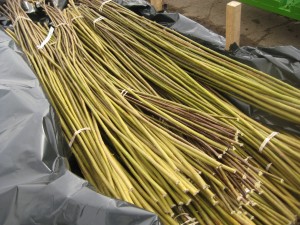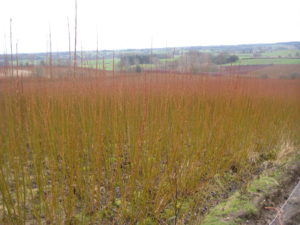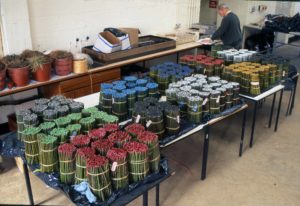Make your own biomass willow rods and cuttings? Please leave it to the experts

Premium biomass willow rods are graded into bundles of 25. Reasonably priced and ready to plant with no hassle.
Once in a while a customer enquires whether they can use material that they have already planted to plant new areas. The answer is no. This is because that all biomass willow varieties that we sell are protected by Plant Breeders’ Rights (PBR). This means that you would need the agreement of the plant breeder or the rights holder for a particular variety to multiply. If you decide to multiply without their permission you would be performing an illegal act.
You might think – “I’m only doing a few hectares. What’s the harm? They’ll never know.”
OK let’s think about that. Each variety has gone through a 15 year process. To get a new variety a breeder creates many crosses in a glasshouse, rears tens of thousands of seedlings and selects around 600 to be planted in a first observation trial that lasts 3-4 years. The 30 best from these go on to a second observation trial lasting another 4 years from which around 5-10 go into a 6 year yield trial. The highest yielding, disease and pest resistant varieties with the best growth habits are selected to become new varieties. At this stage the new variety is registered with the Community Plant Variety Office and goes through more independent tests to ensure that it is distinct from existing varieties. All the while the breeder or rights holder is multiplying up stock so they can sell to the market. Every stage of the process incurs a financial outlay to the breeder or rights holder. By the time it is ready to sell on the open market a new variety has probably cost around £25,000 – £50,000 to produce.
The breeder protects this investment through PBR. If you illegally multiply a cutting you are preventing the breeder from recouping these costs. If enough people do this then the breeder goes bust and no new varieties are produced. Companies involved in willow breeding are not large multi nationals they tend to be small farming enterprises. Would you go to the local farm shop and steal a free range chicken? Probably not? But illegally making cuttings is essentially thieving from a similarly sized small business.
Apart from the illegality and morality of making your own cuttings there are practical issues that you should consider. Companies producing premium grade rods and cuttings are set up to do this. They have the right machinery and skilled teams doing the work. Each rod is harvested and graded (e.g. material with bendy rods or side branches are eliminated) and then cut to size and grouped into bundles of 25. The tops and bottoms of rods and cuttings have a minimum and maximum size so that everything fits through a planting machine appropriately.

Multiplication plantations are stocked at 50,000 plants per hectare. This means that the rods are bolt upright and have little or no sidebranching.
If you did this yourself you would be setting yourself up with a thoroughly miserable task. Let’s say you wanted to plant 10 hectares from cut back material. You would need 150,000 cuttings ultimately so around 15,000 rods to go through the planter. Cut back material from establishment plots is thin, wispy, curved and often side branched. This is because commercial plots are planted at 15,000 plants per hectare whilst cutting beds are planted at 50,000 plants per hectare. The denser planting of the latter ensures that rods compete against each other and promote upright straight growth. You simply won’t get this from cut back material.
Even if you do persevere and prepare material to plant you would end up with all sorts of straggly material. This would be an absolute nightmare to deal with for operatives on the back of a Step Planter. Any planting contractor would hopefully refuse the job but even if they went for it (no questions asked) they would be foolish if they didn’t charge double for the hassle factor.
As the video here shows the Step Planter needs material fed in really quickly in order to make sure that the plot is stocked regularly and there are not large gaps. A 1 second delay in introducing a rod means a gap of 5m. If you are using cut back material you’ll end up with a trial that has gaps all over. This will mean weed ingress, less yield and harvesting difficulties going forward.
Furthermore, irregular size material will almost certainly lead to blockages in the planter mechanism and downtime spent clearing these. A planting job will therefore take far longer. Surely, it’s far better and moral to buy in the premium grade material that will allow a no bother experience?

All our cuttings have painted tops which makes it very hard for them to be planted the wrong way up. A simple thing that makes a real difference.
With short 20cm cuttings that are manually planted you might think things would be easier? All our cuttings have painted tops to indicate the right way to plant. This means that it is very difficult to plant a cutting upside down! I have experienced a case when a grower used cut back material for gapping up – I was amazed by how many were planted the wrong way with the buds facing down. It appears that the operatives involved took the easy option and stuck the thin end in the ground rather than the thick end. Result – lots of effort but no growth!
All in all you’d be mad to try and replicate the work of skilled SRC rod and cuttings suppliers. Our prices are reasonable and provide us with some recompense for the work required to produce a new elite variety. If you decide to go it alone well good luck – I think you might need it!